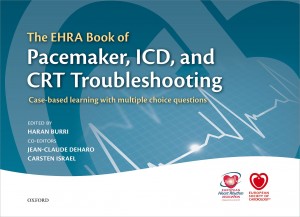The EHRA book of pacemaker, ICD, and CRT troubleshooting
 Editors: Burri H, Deharo J-C, Israel C
Editors: Burri H, Deharo J-C, Israel C
Publisher: Oxford University Press, Oxford, 2015
ISBN: 978-0-19-872777-4 Price: £59.99
This case-based study guide for implantable device troubleshooting is composed of 70 ‘real-life’ cases involving pacemakers, implantable cardio-defibrillators (ICDs) and cardiac resynchronisation therapy (CRT) devices. It is aimed at all physicians and physiologists involved in the management of patients with implantable devices, and is the first in a series of specialist ‘handbooks’ produced by the European Heart Rhythm Association (EHRA). As such it particularly geared towards those sitting the EHRA affiliation examinations, although it would be equally useful to those planning to sit the British or American equivalents.
The cases are split into three sections (pacemakers 35 cases, ICDs 18 cases and CRT 17 cases) and ordered in sequence of increasing complexity, building on the knowledge acquired from previous cases. The electrograms (EGMs), device print-outs, and illustrations are well chosen and of very high reprographic quality, and the layout is not cramped as can sometimes be the case in such publications.
The questions all follow a multiple choice format, and the explanations to the answers are generally succinct yet sufficiently detailed; although in some cases where more than one answer is plausible it would be useful for the reader to also have a more detailed explanation of the reasons for the exclusion of the incorrect choices.
Many of the more complex areas are covered in good detail across several cases, although it is important for the reader to remember that this is designed to be a teaching aid rather than a reference text, and so should be used alongside a more comprehensive resource. For example inter-manufacturer algorithm differences are not always covered in detail, except in certain circumstances. Fundamentally, however, the key to attaining proficiency in this area is acquiring a good general understanding of the principles that underpin the programming of all devices.
These skills transcend manufacturer and model differences, and the authors lead the reader through these generic skills in a logical fashion, stressing the importance of a systematic approach to problem solving which is outlined in the introductory section. Helpfully the authors also point the reader towards a number of key publications which supplement further reading, and this book also contains a very useful glossary of commonly used annotations, and a number of good lists for revision purposes.
Overall, this is a very welcome addition to an increasingly important and complex area of cardiac care. The authors have produced a high quality study aid, which although not exhaustive, covers most of the key areas required for proficiency in device programming and troubleshooting, and as such can serve as an invaluable resource for either refreshing knowledge, or preparing for professional exams.
Dewi E Thomas
Fellow in Cardiac Electrophysiology
James Cook University Hospital, Middlesbrough
